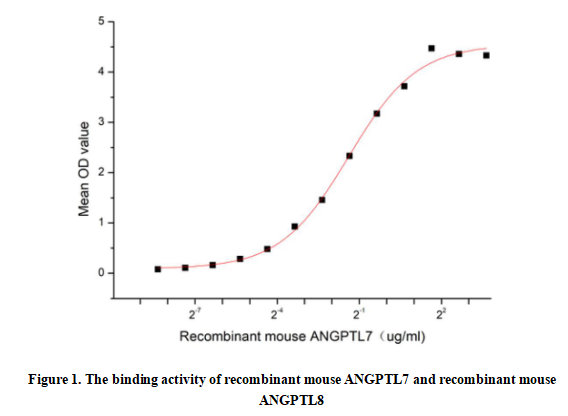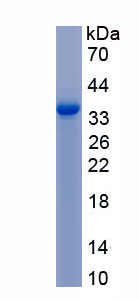Active Angiopoietin Like Protein 7 (ANGPTL7) 

CDT6; AngX; Cornea-Derived Transcript 6; Angiopoietin-related protein 7; Angiopoietin-like factor
- UOM
- FOB US$ 236.00 US$ 590.00 US$ 1,180.00 US$ 3,540.00 US$ 8,850.00
- Quantity
Overview
Properties
- Product No.APR176Mu01
- Organism SpeciesMus musculus (Mouse) Same name, Different species.
- ApplicationsCell culture; Activity Assays.
Research use only - DownloadInstruction Manual
- CategoryCardiovascular biology
- Buffer FormulationPBS, pH7.4, containing 0.01% SKL, 5% Trehalose.
- Traits Freeze-dried powder, Purity > 95%
- Isoelectric Point8.0
Sign into your account
Share a new citation as an author
Upload your experimental result
Review

Contact us
Please fill in the blank.
Activity test

ANGPTL7, short for Angiopoietin-like protein 7, is a member of the angiopoietin-like protein family, which is known for its diverse roles in angiogenesis, lipid metabolism, and other biological processes. ANGPTL7 is primarily expressed in the eye, particularly in the cornea and retina, and has been implicated in ocular development and maintenance of corneal transparency. It is believed to play a role in the regulation of cell growth and survival, and may be involved in the pathogenesis of certain eye diseases. It also play a role in the development of certain diseases, such as cancer, and has been studied for its potential as a biomarker or therapeutic target. The interaction between ANGPTL8 and ANGPTL7 may play an important role in biological activities such as cell signal transduction, cell adhesion or intracellular material transport. Thus a functional binding ELISA assay was conducted to detect the interaction of recombinant mouse ANGPTL7 and recombinant mouse ANGPTL8. Briefly, ANGPTL7 was diluted serially in PBS with 0.01% BSA (pH 7.4). Duplicate samples of 100 μl were then transferred to ANGPTL8-coated microtiter wells and incubated for 1h at 37℃. Wells were washed with PBST and incubated for 1h with anti-ANGPTL7 pAb, then aspirated and washed 3 times. After incubation with HRP labelled secondary antibody for 1h at 37℃, wells were aspirated and washed 5 times. With the addition of substrate solution, wells were incubated 15-25 minutes at 37℃. Finally, add 50 µL stop solution to the wells and read at 450/630 nm immediately. The binding activity of recombinant mouse ANGPTL7 and recombinant mouse ANGPTL8 was shown in Figure 1, the EC50 for this effect is 0.38 ug/mL.
Usage
Reconstitute in 10mM PBS (pH7.4) to a concentration of 0.1-1.0 mg/mL. Do not vortex.
Storage
Avoid repeated freeze/thaw cycles. Store at 2-8°C for one month. Aliquot and store at -80°C for 12 months.
Stability
The thermal stability is described by the loss rate. The loss rate was determined by accelerated thermal degradation test, that is, incubate the protein at 37°C for 48h, and no obvious degradation and precipitation were observed. The loss rate is less than 5% within the expiration date under appropriate storage condition.
Increment services
-
 BCA Protein Quantification Kit
BCA Protein Quantification Kit
-
 Molecular Mass Marker for Protein
Molecular Mass Marker for Protein
-
 Monoclonal Antibody Customized Service
Monoclonal Antibody Customized Service
-
 Polyclonal Antibody Customized Service
Polyclonal Antibody Customized Service
-
 Protein Activity Test Experiment Service
Protein Activity Test Experiment Service
-
 Electrophoretic Mobility Shift Assay (EMSA) Experiment Service
Electrophoretic Mobility Shift Assay (EMSA) Experiment Service
-
 Buffer
Buffer
-
 Lentivirus Packaging Experiment Service
Lentivirus Packaging Experiment Service
-
 Adenovirus Packaging Experiment Service
Adenovirus Packaging Experiment Service
-
 Real Time PCR Experimental Service
Real Time PCR Experimental Service
-
 Spike RBD Protein (S-RBD)
Spike RBD Protein (S-RBD)
-
 Protein G
Protein G
-
 Protein A
Protein A







